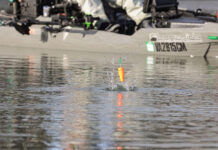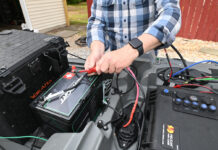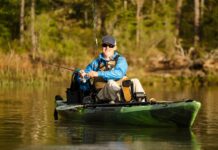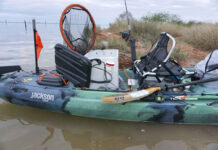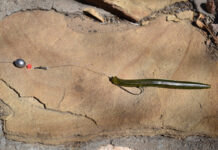For many anglers, the biggest challenge of owning a fishing boat can be transporting it. Unlike lighter, smaller recreational or touring kayaks, fishing kayaks can weigh more than 100 pounds and measure more than 40 inches wide. Since ferrying the kayak to and from your fishing grounds will bookend every excursion, it’s essential to find a secure and hassle-free transportation solution.
Best Ways to Transport Your Fishing Kayak
Ideally, a big fishing kayak is transported on a small trailer. Kayak trailers are lower to the ground, easier to load and almost surely rated to carry more weight than your vehicle’s roof. A trailer is also more aerodynamic, hiding the boat from the wind, saving fuel and reducing wear on your car.
No trailer? The next best option is sliding a kayak in the bed of a pickup truck, if you have one. A full-size truck with an eight-foot bed and the gate down will haul any size kayak without modifications. For a truck with a shorter bed, use a bed extender—a long T-bar extending out the back to support the overhanging kayak; it attaches using a trailer hitch receiver. A couple straps and a red flag, and off you go. Another option is a truck bed rack system, like the one shown in the feature photo above.
Transport Your Kayak Using a Roof Rack
For the rest of us, the kayak has to go on our vehicle’s roof. In a pinch, resting the kayak on foam blocks—or even pool noodles—on the roof will get it home from the paddle shop, but repeatedly loading and securing the kayak like this runs a good chance of damaging the vehicle’s roof. The straps then go through the door frames and round. It’s a bit Mickey Mouse for everyday use. What you need is a suitable roof rack.
It is generally not recommended to put a kayak weighing more than 80 pounds and 38 inches wide onto factory roof racks. Very few factory rack systems have official carrying capacity ratings enough to hold a heavy fishing kayaks, especially when factoring in accessories, the wind and air resistance or the force generated in an emergency stop or crash. Check your owner’s manual for specifics on carrying capacity, but we’re pretty sure you’ll be upgrading.
To more safely chauffeur your kayak to and fro, upgrade your factory luggage rack to a base rack system from a reputable aftermarket roof rack company. A base rack system is simply a good set of feet and bars upon which all other rack accessories are mounted. Aftermarket base racks are specific to your vehicle and designed for heavier and unwieldy loads.
We tend to go a size or two wider than recommended so the bars stick out further from the vehicle. Bars extending past the roof lines are easier to load. Going wider may also allow two boats, not just one. Too wide and your friends will be bumping their heads. You can transport your fishing kayak flat on the bare bars or add kayak saddles.
Kayak Rollers and Lift-Assist Accessories
Of course, you’ve got to get it up there first. If powerlifting 80 pounds of rotomolded plastic isn’t your idea of a good time, look to aftermarket accessories to help get the kayak off the ground and onto the roof.
Kayak rollers are economical and straightforward. They work just as they sound. With a roller or saddle with roll assist or sliders, simply place the kayak on the ground behind the vehicle with the bow pointing towards the bumper. Lift the bow and rest it on the roller. Once you have the bow up, lift the stern and walk forward, pushing the kayak along—the roller will allow the boat to roll forward. This essentially halves the amount of weight the paddler has to lift. Rollers work best when the rear crossbar is close to the back of the vehicle, like on a station wagon without a trunk to reach over. If installed more than a foot forward of the end of the roof, you may need a slide-out load-assist bar to keep your kayak from rubbing against the back of your vehicle.
A lift-assist kayak rack accessory full of springs and hydraulic dampeners offers the easiest way for a solo paddler to load a kayak alongside the car. This feature adds to an existing base rack system and doubles the price. Many lift-assist systems can share up to 40 pounds of the lifting. So, on an 80-pound kayak, the paddler only has to lift 40 pounds—a total game-changer and worth the money for many anglers.
How to Transport Multiple Kayaks
To carry a second kayak on a car, some paddlers go with J-racks to elevate and angle the kayaks. Tilted, they take up less space from side to side, like standing plates in a dishwater. This is an excellent option for light kayaks or paddleboards, but it’s tough to singlehandedly load big kayaks this way unless you are using a lift assist accessory specially designed for J-racks, like the Telos XL from Malone Auto Racks.
J-racks have some other drawbacks, too. Not only is the combined weight of two fishing kayaks likely beyond the capacity of most roofs, but the boats stick up like huge plastic sails, killing gas milage and offering opportunities for failure—like say, parking garages. If you are often transporting multiple fishing kayaks with a single vehicle, you’re back to a pickup truck or towing a small trailer.

4 Steps to Tie Down Your Fishing Kayak
1 Lift and Position Boat on Roof
Park on level ground. Lift the bow onto the rear rack or load-assist bar. Be sure the boat won’t slide or blow off the rack. Then lift the stern end to push the boat forward onto both bars or saddles. Balance the kayak on the bars so it does not tip forward or backward. Usually, the kayak brand logo on the side of the hull is center of the boat; use this as a guide evenly spaced between the crossbars. Position the kayak so it is perfectly parallel with your vehicle. If it is slightly misaligned, the wind will put uneven pressure on one side of your boat the entire drive. And it looks sketchy.
2 Add Tie-Down Straps and Buckles
You can use ropes and trucker hitches, of course, but we like to use a set of one-inch straps with cam buckles to secure a boat to the bars. Standing on the passenger side, toss the non-buckle end of the strap over the kayak, pass the end under the bar and throw it back over the kayak. If you are only transporting one kayak, it’s safer to buckle on the passenger side in case you need to do a roadside adjustment. You can toss the buckle end if you don’t care about dents in your roof. Line up the buckle with the top edge of the kayak or gunwale. We like to double wrap the working end of the strap around the bar to prevent it from sliding side to side on the bar. Sometimes we include one twist in the strap to stop it from vibrating in the wind. A crazy loud hum at highway speeds will remind you. Thread through the backside of the buckle to start the tightening process.
3 Tighten Straps and Check Boat
Cinch down the strap, wrap around the bar and then tie off the loose end with a couple backup half hitches to keep the loose end from flapping in the wind or against your paint. Do steps 2 to 3 for both the front and rear racks. To ensure the kayak is secure, try shaking it with both hands. The kayak should not move on the bars. The vehicle should rock on its suspension as you try to move the kayak.
4 Tie Down Bow and Stern With Rope
Bow and stern lines add security to the whole system by adding redundancy to your strapping system or in case your roof rack fails and detaches from the vehicle. Lightweight ratchet straps or another set of cam straps are simple to use but be careful not to put too much torque on the ends of your kayak.
We find straps flap in the wind and prefer ropes for bow and stern lines. Lengths of 550 paracord tied from the bow and stern and to the vehicle and tightened with trucker’s hitch knots do the trick. Many cars have built-in attachment points under the front and back of the vehicle. If you don’t, consider installing hood or trunk tie-down loops which can be found at your local paddling shop or make a fun DIY project. Whatever you do, don’t tie off to the plastic grills or air dams found on many new vehicles—they’re not secure attachment points. Ensure your lines are well clear of wheel wells and secure any loose ends. Get in the habit of periodically checking all straps and lines, especially after getting wet in a rain.
This article was first published in Paddling Magazine Issue 63. Subscribe to Paddling Magazine’s print and digital editions here, or browse the archives here.
‘Cause when it comes to moving me / You know you guys are the CHAMPS. —Jackson Browne | Feature photo: Kevin Whitley

